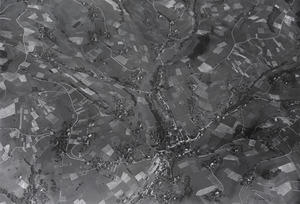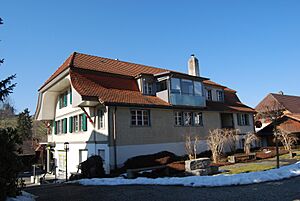Eriswil facts for kids
Quick facts for kids
Eriswil
|
||
|---|---|---|
 |
||
|
||
| Country | Switzerland | |
| Canton | Bern | |
| District | Emmental | |
| Area | ||
| • Total | 11.34 km2 (4.38 sq mi) | |
| Elevation | 740 m (2,430 ft) | |
| Population
(Dec 2020 )
|
||
| • Total | 1,358 | |
| • Density | 119.75/km2 (310.16/sq mi) | |
| Postal code |
4952
|
|
| Surrounded by | Huttwil, Luthern (LU), Sumiswald, Ufhusen (LU), Wyssachen | |
Eriswil is a small town, also called a municipality, in Switzerland. It's located in the Emmental area, which is part of the Bern canton.
Contents
A Look Back in Time (History)
Eriswil was first written about in the year 1256. Back then, it was called Erolzwile. We don't know much about Eriswil's very early days.
During the Middle Ages, a local noble family, the von Eriswil family, lived here. They were like special knights called Ministerialis. They served powerful lords known as the Counts of Kyburg. However, this family died out in the 1300s.
Later, in the late 1300s, the area became part of St. Gallen. Then, over the next 100 years, the city of Bern grew and took control of the region. In 1504, Bern bought the whole area. Eriswil then became part of the Trachselwald district.
The Village Church
The church in Eriswil was originally connected to the Abbey of Saint Gall. The oldest part of the church, the bell tower, is from around the 1300s. The part where the choir sings was built in the 1500s. The main part of the church, called the nave, was built much later in 1905.
In 1528, Bern chose a new religion called the Protestant Reformation. Eriswil also changed its faith then, which meant it mostly separated from the Abbey. Until 1966, the church in Eriswil also served the nearby village of Wyssachen.
Village Life and Work
For a long time, Eriswil's economy was all about agriculture, which means farming. By the 1600s, the village had two main groups of people. There were the well-off farmers who owned land. Then there were many poor Tauner. These Tauner had fewer rights and worked as sharecroppers, meaning they farmed land for others and shared the crops.
In 1622, the village decided to stop new Tauner from moving in. They also stopped them from building houses on common land. In the 1700s, many Tauner started making canvas cloth in small home workshops. By 1750, making canvas at home was a very busy business in the village.
Around 1860, large factories took over from the small home weaving. Even with tough economic times and wars, four of these factories kept working. Some even stayed open until the 1970s and 1990s.
Where is Eriswil? (Geography)
Eriswil covers an area of about 11.3 square kilometers (4.3 square miles). A survey from 2006 showed that most of the land, about 67%, is used for farming. Forests cover about 26.1% of the area.
About 6.4% of the municipality has buildings or roads. A very small part, about 0.1%, is rivers or lakes. The same small amount, 0.1%, is land that can't be used for anything.
More specifically, houses and other buildings make up 3.8% of the land. Roads and other transport areas are 2.0%. About 22.7% of the land is covered with thick forests. Another 3.4% has orchards or small groups of trees.
For farming land, 17.0% is used for growing crops. About 46.7% is used for pastures where animals graze. A small part, 2.6%, is for orchards or vineyards. All the water in Eriswil is flowing water, like rivers and streams.
Eriswil is located in the Emmental region. It includes the main village of Eriswil. It also has smaller areas called Gütergemeinden (Vorder- and Hinterdorf) and tiny villages called hamlets like Neuligen and Schwendi. Schwendi became part of Eriswil in 1888-89.
In 2010, Eriswil joined a new administrative area called Verwaltungskreis Oberaargau.
Who Lives Here? (Demographics)
Eriswil has a population of about 1,360 people as of December 2012. About 3.6% of these people are foreign nationals. Between 2010 and 2012, the population changed a little, by 0.3%. More people moved into Eriswil (0.7%) than left, and there were slightly more births than deaths (0.2%).
Most people in Eriswil speak German as their first language (97.5%). A smaller number speak Albanian (0.8%) or French (0.3%). A few people also speak Italian or Romansh.
As of 2013, the population was almost evenly split between males (49.9%) and females (50.1%). Most residents are Swiss citizens. About 49.6% of the people living in Eriswil in 2000 were also born there. Many others were born in the same canton (29.7%) or elsewhere in Switzerland (12.2%). About 5.1% were born outside Switzerland.
In 2012, children and teenagers (up to 19 years old) made up 23.4% of the population. Adults (20-64 years old) were 56.5%, and seniors (over 64 years old) were 20.1%.
In 2000, about 602 people in Eriswil were single and had never been married. There were 690 married people, 106 widows or widowers, and 41 divorced people.
Homes and Housing
In 2010, there were 169 homes where only one person lived. There were also 53 homes with five or more people. In 2000, most apartments (85.5%) were lived in all the time. A small number (7.4%) were used only at certain times of the year, and 7.1% were empty.
In 2012, new homes were being built at a rate of 0.7 new homes for every 1000 residents. In 2013, about 1.0% of homes were empty. In 2012, single-family homes made up 38.4% of all housing in Eriswil.
The chart below shows how the population of Eriswil has changed over time:

Working in Eriswil (Economy)
In 2011, Eriswil had a low unemployment rate of 0.83%. This means almost everyone who wanted a job had one. In the same year, 465 people worked in the municipality.
- 170 people worked in the primary sector, which includes farming and forestry. There were about 62 businesses in this area.
- 110 people worked in the secondary sector, which includes manufacturing and construction. There were 27 businesses in this area.
- 185 people worked in the tertiary sector, which includes services like shops, schools, and healthcare. There were 51 businesses in this area.
Overall, 749 residents of Eriswil had jobs. About 39.7% of these workers were women.
Types of Jobs
In 2008, there were 307 full-time equivalent jobs in Eriswil.
- 115 jobs were in farming.
- 98 jobs were in the secondary sector. Most of these (79.6%) were in manufacturing, and 20.4% were in construction.
- 94 jobs were in the tertiary sector. These included jobs in:
- Shops and vehicle repair (20.2%)
- Moving and storing goods (5.3%)
- Hotels and restaurants (5.3%)
- Insurance or finance (1 job)
- Education (13.8%)
- Healthcare (28.7%)
Commuting and Taxes
In 2000, 74 workers came into Eriswil for their jobs. However, 454 workers left Eriswil to work somewhere else. This means many more people leave Eriswil for work than come in. About 79.9% of the workers in Eriswil also lived there.
For getting to work, 8.1% of people used public transportation. A larger number, 55.5%, used a private car.
In 2013, the average tax rate for a married person with two children in Eriswil was 11.8%. For a single person, it was 18.1%. These rates were very similar to the average for the whole canton of Bern.
In 2011, 473 people paid taxes in Eriswil. Most workers (117) earned between 50,000 and 75,000 Swiss Francs (CHF) per year. The average income for those earning over 75,000 CHF in Eriswil was 106,312 CHF.
In 2011, a small part of the population, 2.0%, received financial help from the government.
Beliefs and Faiths (Religion)
According to the 2000 census, most people in Eriswil (77.1%) belonged to the Swiss Reformed Church. About 7.4% were Roman Catholic.
Other Christian groups included:
- Orthodox church members (0.35%)
- Christian Catholic Church members (0.14%)
- Other Christian churches (5.63%)
There was also one person who was Jewish. About 1.18% of the population was Muslim. There were 22 people who were Hindu, and one person belonged to another church. About 3.82% of the people said they had no religion, or were agnostic or atheist. About 2.71% did not answer the question about their religion.
Weather in Eriswil (Climate)
Between 1981 and 2010, Eriswil had about 142.2 days of rain or snow each year. On average, it received about 1282 millimeters (50.5 inches) of precipitation annually.
The wettest month was May, with an average of 139 millimeters (5.5 inches) of rain or snow. It rained or snowed for about 14.1 days in May. The driest month was February, with an average of 78 millimeters (3.1 inches) of precipitation over 10.9 days.
Learning and Schools (Education)
In Eriswil, about 55.8% of people have finished non-mandatory upper secondary education. This is schooling after the basic required years. About 10.8% have gone on to higher education, like university or a specialized college called a Fachhochschule. Of those with higher education, most were Swiss men (75.8%) or Swiss women (20.9%).
The school system in the Canton of Bern works like this:
- One year of optional Kindergarten.
- Six years of Primary school.
- Three years of required lower Secondary school. Students are grouped by their abilities.
- After lower Secondary, students can continue their education or start an apprenticeship (learning a trade on the job).
School Year 2012-2013
During the 2012-13 school year, 147 students attended classes in Eriswil.
- There were 18 students in German-language kindergarten classes. A small percentage of these students (5.6%) were not Swiss citizens, and 5.6% spoke a different language at home.
- The primary school had 103 students in German-language classes. About 5.8% were not Swiss citizens, and 6.8% spoke a different language at home.
- 26 students from Eriswil attended lower secondary schools in nearby towns. Of these, 7.7% were not Swiss citizens and spoke a different language at home.
In 2000, 147 students went to school in Eriswil. Of these, 115 lived and went to school in Eriswil. The other 32 students came from other towns. In the same year, 85 residents of Eriswil went to schools outside the municipality.
See also
 In Spanish: Eriswil para niños
In Spanish: Eriswil para niños










